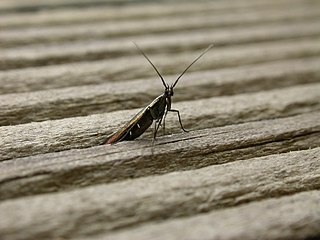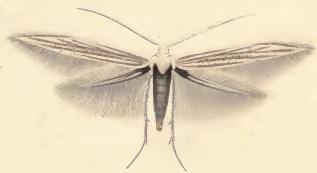
Erica is a genus of roughly 857 species of flowering plants in the family Ericaceae. The English common names heath and heather are shared by some closely related genera of similar appearance. The genus Calluna was formerly included in Erica – it differs in having even smaller scale-leaves, and the flower corolla consisting of separate petals. Erica is sometimes referred to as "winter heather" to distinguish it from Calluna "summer heather".

The Coleophoridae are a family of small moths, belonging to the huge superfamily Gelechioidea. Collectively known as case-bearers, casebearing moths or case moths, this family is represented on all continents, but the majority are found in temperate areas of the Northern Hemisphere. They are most common in the Palearctic, and rare in sub-Saharan Africa, South America, and Australia; consequently, they probably originated in northern Eurasia. They are relatively common in houses, they seek out moist areas to rest and procreate.

Coleophora is a very large genus of moths of the family Coleophoridae. It contains some 1,350 described species. The genus is represented on all continents, but the majority are found in the Nearctic and Palaearctic regions. Many authors have tried splitting the genus into numerous smaller ones, but most of these have not become widely accepted.

Cupressus lusitanica, the Mexican cedar or cedar-of-Goa, is a species of cypress native to Mexico and Central America. It has also been introduced to Belize, Costa Rica and Nicaragua, growing at 1,200–3,000 metres (3,900–9,800 ft) altitude.

The gold-striped salamander or golden-striped salamander is a species of salamander in the family Salamandridae. It is the only species of the genus Chioglossa. It is found in the north-west of Iberia at an altitude of up to 1,300 m. It is threatened by habitat loss.

Prunus lusitanica, the Portuguese laurel cherry or Portugal laurel, is a species of flowering plant in the rose family Rosaceae, native to southwestern France, Spain, Portugal, Morocco, and Macaronesia.

Quercus lusitanica, commonly known as gall oak, Lusitanian oak, or dyer's oak, is a species of oak native to Portugal, Spain and Morocco. Quercus lusitanica is the source of commercial nutgalls. These galls are produced by the infection from the insect Cynips gallae tinctoriae. They are used for dyeing.

Erica lusitanica is a species of flowering plant in the family Ericaceae, known by the common names Portuguese heath and Spanish heath. It is native to Portugal, Spain and southwestern France. It is named for Lusitania, a historical region encompassing most of modern Portugal and parts of western Spain.

Coleophora serratella is a moth of the family Coleophoridae. It is found in Europe, Japan (Hokkaido) and North America.

Coleophora limosipennella is a moth of the family Coleophoridae described by Philogène Auguste Joseph Duponchel in 1843. It is found in Europe from Fennoscandia to the Pyrenees, Italy and the Balkan Peninsula and from Great Britain to the Baltic States and Romania. It is an introduced species in North America.

Coleophora vestianella is a moth of the family Coleophoridae. It is found from Europe to Asia Minor, Iran, Afghanistan, China, the Korean Peninsula and Japan.

Coleophora anatipennella is a moth of the case-bearer family (Coleophoridae).

The clover case-bearer or small clover case-bearer is a moth of the family Coleophoridae. It is native to Asia, Europe and North Africa, and has been introduced to Australia and New Zealand.
Selenemys is an extinct genus of pleurosternid turtle from the Late Jurassic of Central West of Portugal. It is known from several specimens recovered from the Lusitanian Basin, dating to the upper Kimmeridgian age. It was one of the earliest European pleurosternids, more closely related to the later Cretaceous pleurosternids of Europe than the contemporary pleurosternids of North America. This genus was named by Adán Pérez-García and Francisco Ortega in 2011, and the type species is Selenemys lusitanica.

The metallic coleophora moth is a moth of the family Coleophoridae. It is native to Europe and Armenia, but is an adventive species in the Nearctic realm, where it is found throughout the United States and southern Canada. It has also been recorded from New Zealand, Chile and Argentina.

Coleophora virgatella is a moth of the family Coleophoridae. It is found from Germany and Poland to the Pyrenees, Italy and Greece. It has also been recorded from southern Russia and central Asia.

Coleophora auricella is a moth of the family Coleophoridae. It is found from Germany and Poland to Spain, Italy and Romania. It has also been recorded from southern Russia.

Coleophora colutella is a moth of the family Coleophoridae. It is found in all of Europe, except Great Britain and Ireland. It is an introduced species in North America.

Coleophora millefolii is a moth of the family Coleophoridae. It is found in most of Europe, except Great Britain, Ireland and the Iberian Peninsula.

Coleophora ochripennella is a species of moth from the family Coleophoridae. It is found from Germany and Poland to the Pyrenees, Italy and Greece.












